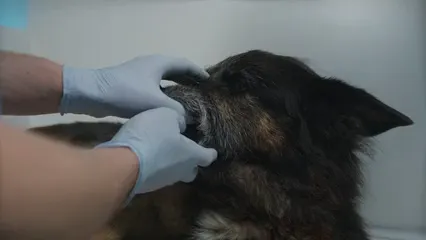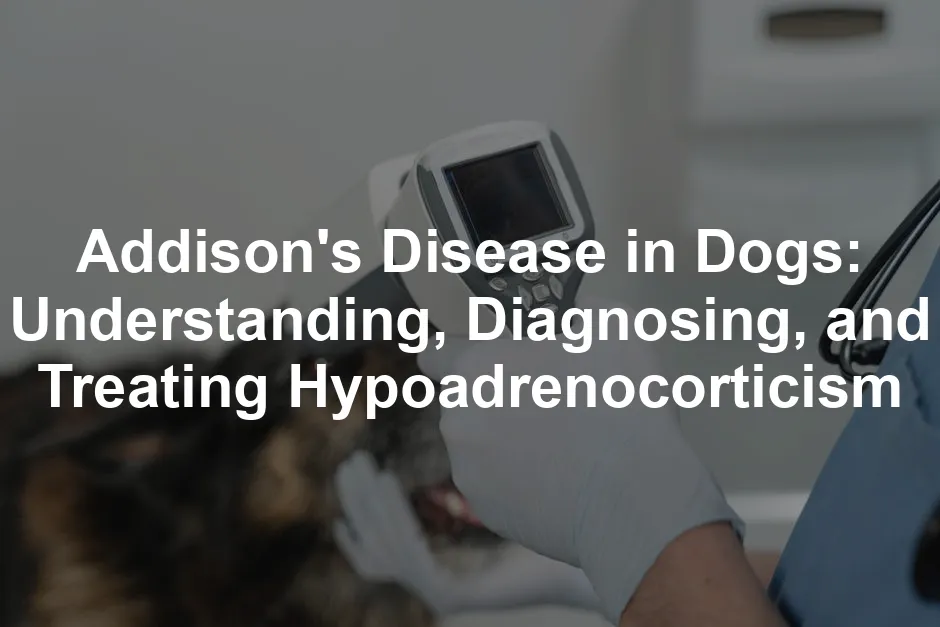Introduction
Addison’s disease, or hypoadrenocorticism, is a serious condition affecting dogs. It occurs when adrenal glands fail to produce enough vital hormones. This disease is significant in canine health due to its potentially life-threatening effects. Awareness among dog owners is crucial for early detection and treatment. In this post, we’ll explore the symptoms, diagnosis, treatment, and ongoing management of Addison’s disease in dogs.
If your pup struggles with stomach issues, you might want to consider a Dog Food for Sensitive Stomachs. It’s designed to minimize gastrointestinal discomfort, allowing your furry friend to enjoy their meals without the worry of upset tummies!
Summary and Overview
Addison’s disease impacts dogs by causing a deficiency in two critical hormones: cortisol and aldosterone. The adrenal glands are responsible for producing these hormones, which regulate numerous bodily functions, including metabolism, stress response, and electrolyte balance. When these hormones are insufficient, dogs may experience severe health issues.
Certain breeds are more prone to this condition, such as Standard Poodles, Bearded Collies, and Great Danes. The disease is particularly common in young to middle-aged female dogs. Timely diagnosis and treatment are vital, as untreated Addison’s disease can lead to serious complications, including an Addisonian crisis, which can be life-threatening. Recognizing the signs early can significantly improve outcomes for affected dogs.
For those unexpected moments when your furry friend gets into trouble, a Pet First Aid Kit can be a lifesaver. Packed with essential supplies, it ensures you’re ready for any canine emergency—because we all know dogs can be a bit clumsy at times!

Understanding Addison’s Disease
What is Addison’s Disease?
Addison’s disease, also known as hypoadrenocorticism, is a hormonal disorder caused by insufficient production of crucial adrenal hormones. It typically results from autoimmune destruction of the adrenal glands, which leads to a deficiency in both glucocorticoids (like cortisol) and mineralocorticoids (like aldosterone). These hormones play essential roles in regulating metabolism, blood pressure, and the body’s response to stress.
The adrenal glands, located near the kidneys, are vital for maintaining homeostasis in the body. Cortisol helps manage stress, while aldosterone regulates sodium and potassium levels, crucial for fluid balance. When these hormones are deficient, dogs may exhibit various symptoms, making diagnosis challenging.
Certain breeds are more susceptible to this condition, including Standard Poodles, Bearded Collies, and Great Danes. The condition can affect any dog, but younger females are often at higher risk. Awareness of the signs and symptoms is essential for prompt veterinary intervention, as early diagnosis and effective management can lead to a good quality of life for affected dogs.
For those pups needing a little extra support, Dog Supplements for Joint Health are a great way to keep their joints happy and healthy. After all, we want our furry friends to jump and play without the worry of aching joints!

Causes of Addison’s Disease
Addison’s disease in dogs arises primarily from immune-mediated destruction of the adrenal glands. This autoimmune process leads to reduced production of crucial hormones, specifically cortisol and aldosterone. Estimates suggest that approximately 70-90% of Addison’s cases are due to autoimmune disorders, highlighting the significance of this factor.
In addition to autoimmune causes, other factors can contribute to adrenal gland damage. Trauma, infections, and certain medications may impair adrenal function. For instance, medications used in Cushing’s disease treatment can inadvertently cause adrenal insufficiency. Rarely, tumors or defects in the pituitary gland can also lead to secondary Addison’s disease by affecting hormone regulation.
Genetic predisposition may play a role as well. Specific breeds, including Standard Poodles and Bearded Collies, are more commonly affected, suggesting a hereditary component. Understanding these causes helps in early detection and management of Addison’s disease, ensuring the best outcomes for our canine companions.
Symptoms of Addison’s Disease
Common Symptoms
Addison’s disease often presents with vague and non-specific symptoms, making it known as “the great imitator.” Common signs include lethargy, vomiting, and diarrhea. Affected dogs may also show changes in appetite, leading to weight loss over time. Increased thirst and urination can occur as the body struggles to maintain fluid balance.
These symptoms may fluctuate, worsening during stressful situations. As the disease progresses, dogs may appear weak or depressed, showing less interest in daily activities. Recognizing these signs early is crucial for timely veterinary intervention.
And speaking of stress, don’t forget to check out Dog Anxiety Relief Supplements. They can help soothe your pup’s nerves during those thunderstorm panic attacks or when the mailman arrives!

Addisonian Crisis
An Addisonian crisis is a severe and life-threatening condition that can arise suddenly. Symptoms include severe vomiting, diarrhea, and collapse. Dogs may exhibit signs of shock, such as rapid breathing, weak pulse, or low heart rate. This crisis requires immediate emergency treatment to stabilize the dog.
Veterinary care during this critical time often involves intravenous fluids and medications to correct electrolyte imbalances. Without prompt intervention, an Addisonian crisis can lead to serious complications or even death. Awareness of this condition is essential for dog owners to ensure their pets receive the care they need in emergencies.

Diagnosis of Addison’s Disease
Diagnostic Tests
Diagnosing Addison’s disease in dogs involves several key tests. Initially, veterinarians perform blood tests to check electrolyte levels. Common findings include low sodium and high potassium, which indicate possible adrenal insufficiency.
The definitive test for Addison’s disease is the ACTH stimulation test. In this test, a synthetic ACTH injection stimulates the adrenal glands to produce cortisol. If the cortisol levels remain low after the injection, it confirms Addison’s disease.
Urinalysis can also provide valuable information. It helps assess kidney function and detect any electrolyte imbalances. Sometimes, imaging tests like X-rays or ultrasounds are used to rule out other conditions affecting the adrenal glands. Together, these diagnostic tools help ensure an accurate diagnosis of Addison’s disease.

While you’re on the lookout for health issues, consider investing in a Pet Camera with Treat Dispenser. This nifty gadget allows you to keep an eye on your furry friend while dispensing treats remotely—perfect for when you’re out and about!
Challenges in Diagnosis
Diagnosing Addison’s disease poses several challenges for veterinarians. One major hurdle is the non-specific symptoms. Many dogs exhibit vague signs like lethargy, vomiting, and diarrhea, which can mimic various other health issues. This often leads to misdiagnosis, especially in acute cases.
Additionally, some dogs may present during an Addisonian crisis, which can complicate the situation further. In these instances, immediate treatment is necessary, and the underlying Addison’s disease may go unrecognized initially.
Veterinarians must maintain a high index of suspicion. Early diagnosis is crucial, as untreated Addison’s disease can lead to severe health complications. Being aware of the signs and swift action can make a significant difference in outcomes for affected dogs.

Long-term Management
Managing Addison’s disease in dogs requires ongoing vigilance. Regular veterinary check-ups are crucial for monitoring your dog’s health. These visits typically include blood tests to evaluate hormone levels and electrolyte balance. Your vet will check for sodium and potassium levels, which can indicate how well the treatment is working.
Adjustments to medication may be necessary based on your dog’s clinical signs and lab results. For example, if your dog shows signs of lethargy or weakness, it might signal that medication needs tweaking. This personalized approach ensures that your dog receives the best care possible.
Failing to monitor properly can lead to serious complications. Regular consultations help maintain your dog’s well-being and prevent crises. With diligent management and a strong partnership with your veterinarian, dogs with Addison’s disease can lead fulfilling lives.

And while you’re managing their health, consider a Dog Grooming Kit to keep them looking sharp. A well-groomed dog is a happy dog, and it’s one less thing to worry about when it comes to their overall health!
Prognosis and Quality of Life
Expected Outcomes
The prognosis for dogs diagnosed with Addison’s disease is generally positive when treated appropriately. With consistent hormone replacement therapy, many dogs can enjoy a normal lifespan. In fact, studies suggest that dogs receiving proper treatment can live as long as their healthy peers.
Quality of life is also a key consideration. Most dogs adapt well to their treatment regimens and show improved energy levels and appetite. Owners often notice a significant difference in their dog’s overall demeanor once they start receiving care. For more insights on enhancing your dog’s quality of life, refer to our guide to improving quality of life for dogs with cognitive dysfunction.
However, it’s essential to remain vigilant. Dogs can still experience stress and potential crises, especially during illness or after surgery. Being aware of these triggers is vital for maintaining your dog’s health. With the right attention and care, dogs with Addison’s disease can thrive.

Speaking of care, a Dog Bed for Joint Support can make a world of difference for your pup’s comfort. A cozy place to rest can help them recuperate and stay comfy, especially if they’re dealing with any health issues!
FAQs
What are the early signs of Addison’s disease in dogs?
The early signs of Addison’s disease in dogs can be subtle. Look for symptoms like lethargy, vomiting, diarrhea, and decreased appetite. Increased thirst and urination may also occur. These early signs of Addison’s disease in dogs can easily be mistaken for other conditions, making awareness crucial.
Can Addison’s disease be cured in dogs?
Unfortunately, Addison’s disease cannot be cured in dogs. However, Addison’s disease treatment and management can effectively control symptoms. Lifelong hormone replacement therapy is necessary to maintain your dog’s health. Regular veterinary check-ups ensure the treatment plan is working.
What breeds are most commonly affected by Addison’s disease?
Certain breeds are more predisposed to Addison’s disease. Breeds predisposed to Addison’s disease include Standard Poodles, Bearded Collies, Great Danes, and Portuguese Water Dogs. Young to middle-aged females from these breeds frequently develop this condition, making awareness essential for pet owners.
How is an Addisonian crisis treated?
An Addisonian crisis requires immediate veterinary attention. Emergency treatment for Addison’s crisis typically involves intravenous fluids and medications to stabilize the dog. Corticosteroids are administered to address hormone deficiencies and restore balance. Prompt treatment is crucial to prevent severe complications.
Is Addison’s disease hereditary in dogs?
Yes, hereditary factors in Addison’s disease can play a role. Certain breeds show a higher incidence of the disease, suggesting a genetic link. While the exact mode of inheritance is still unclear, understanding breed predispositions helps in early detection and management of this condition.
Please let us know what you think about our content by leaving a comment down below!
Thank you for reading till here 🙂
All images from Pexels





